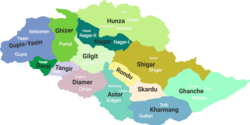Astore District
Astore District
ضلع استور | |
|---|---|
 Nanga Parbat seen from the Rama Valley near Astore District in August 2016 | |
| Country | |
| Territory | |
| Division | Diamer |
| Headquarters | Eidgah |
| Government | |
| • Type | District Administration |
| • Deputy Commissioner | Muhammad Zulqanain Khan |
| • Superintendent of Police | N/A |
| • District Health Officer | N/A |
| Area | |
| • Total | 5,092 km2 (1,966 sq mi) |
| Population (1998) | |
| • Total | 71,666 |
| Number of tehsils | 2 |
Astore District (Urdu: ضلع استور) is one of the 14 districts of the Pakistani-administered territory of Gilgit−Baltistan.[1] Its administrative headquarters are located at Eidgah in the Astore Valley. The Astore District is bounded by Gilgit District to the north, Roundu District to the northeast, Skardu District to the east, Kharmang District to the southeast, Diamer District to the west, the Neelum District of Azad Jammu and Kashmir to the southwest, and the Bandipore District of Indian-administered Jammu and Kashmir to the south.
Astore Valley[edit]
The Astore Valley has an area of 5,092 km² and is at an altitude of 2,600 metres (8,500 ft). The valley has approximately 250 square kilometres (97 sq mi) of glacier cover.[2] The nearest glacier after entering the valley is the Harcho Glacier,[3] and the most accessible glacier is the Siachen Glacier.[4]
Accessibility[edit]
Eidgah is connected to Gilgit, which is well connected by air with Islamabad and by road with Peshawar, Swat, Islamabad-Rawalpindi, Chitral, and Skardu. There are two ways of access to Eidgah. The first is from Skardu via the Deosai Plateau 143 kilometres (89 mi),[5] but that route cannot be used from November to June due to heavy snowfall. The second way, year round, is from Gilgit via Jaglot 128 kilometres (80 mi).[6]
History[edit]
Around 1600, according to the Imperial Gazetteer of India:
Ghāzī Mukhpun, a Persian adventurer, is said to have married a princess of the Skārdu reigning family. The four sons born of this union became Rās of Astor, Kharmang, Rondu, and Skārdu, respectively, and from them are descended the families of the present chiefs of those places. The independence of Astor ceased with the Dogra conquest.[7]
References[edit]
- ^ "GB notifies four more districts, total number of districts now 14". pakistantoday.com.
- ^ Sher Muhammad, Lide Tian, Asif Khan, Early twenty-first century glacier mass losses in the Indus Basin constrained by density assumptions, Journal of Hydrology, Volume 574, 2019, Pages 467-475
- ^ MUHAMMAD, S., TIAN, L., & NÜSSER, M. (2019). No significant mass loss in the glaciers of Astore Basin (North-Western Himalaya), between 1999 and 2016. Journal of Glaciology, 65(250), 270-278. doi:10.1017/jog.2019.5
- ^ Muhammad, S. and Tian, L. (2016) ‘Changes in the ablation zones of glaciers in the western Himalaya and the Karakoram between 1972 and 2015’, Remote Sensing of Environment. Elsevier Inc., 187, pp. 505–512. doi: 10.1016/j.rse.2016.10.034.
- ^ "Distance from Skardu via Deosai Plains". Google Maps. Retrieved 4 August 2019.
- ^ "Distance from Gilgit via Jaglot". Google Maps. Retrieved 4 August 2019.
- ^ Gilgit - Imperial Gazetteer of India, v. 12, p. 239 According to the Imperial Gazetteer, which was compiled in the first decade of the twentieth century, the marriage took place over three hundred years previously.



